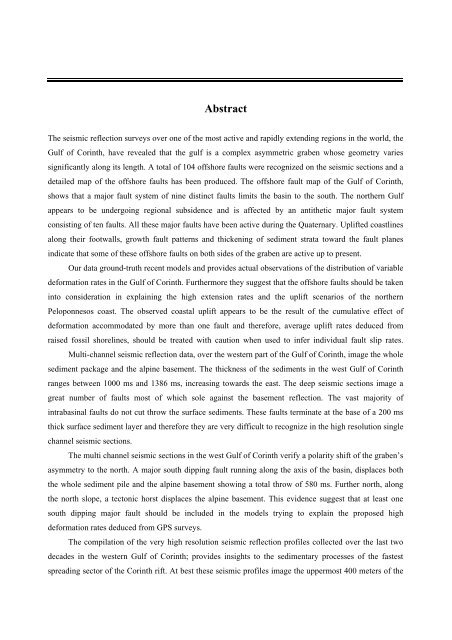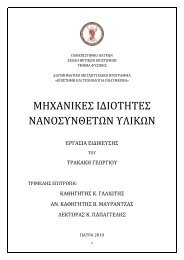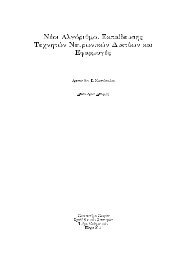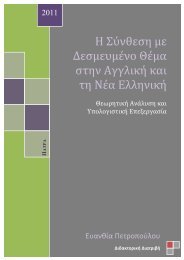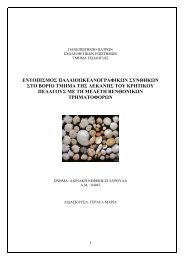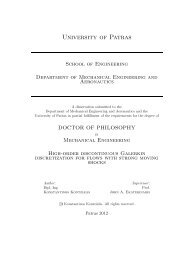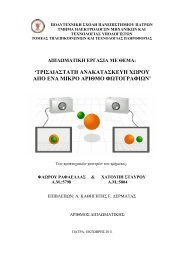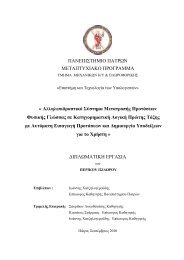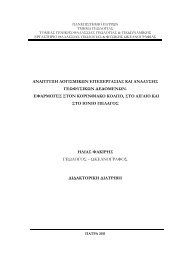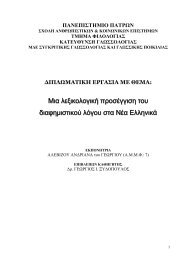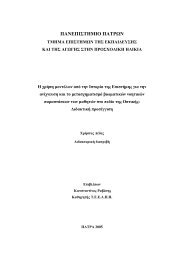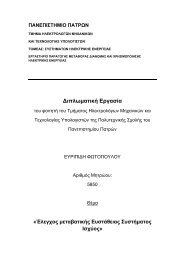μελεÏη ιζημαÏογενÏν âιεÏγαÏιÏν και ÏεκÏονικÏν âομÏν ÏÏον κοÏινθι
μελεÏη ιζημαÏογενÏν âιεÏγαÏιÏν και ÏεκÏονικÏν âομÏν ÏÏον κοÏινθι
μελεÏη ιζημαÏογενÏν âιεÏγαÏιÏν και ÏεκÏονικÏν âομÏν ÏÏον κοÏινθι
You also want an ePaper? Increase the reach of your titles
YUMPU automatically turns print PDFs into web optimized ePapers that Google loves.
AbstractThe seismic reflection surveys over one of the most active and rapidly extending regions in the world, theGulf of Corinth, have revealed that the gulf is a complex asymmetric graben whose geometry variessignificantly along its length. A total of 104 offshore faults were recognized on the seismic sections and adetailed map of the offshore faults has been produced. The offshore fault map of the Gulf of Corinth,shows that a major fault system of nine distinct faults limits the basin to the south. The northern Gulfappears to be undergoing regional subsidence and is affected by an antithetic major fault systemconsisting of ten faults. All these major faults have been active during the Quaternary. Uplifted coastlinesalong their footwalls, growth fault patterns and thickening of sediment strata toward the fault planesindicate that some of these offshore faults on both sides of the graben are active up to present.Our data ground-truth recent models and provides actual observations of the distribution of variabledeformation rates in the Gulf of Corinth. Furthermore they suggest that the offshore faults should be takeninto consideration in explaining the high extension rates and the uplift scenarios of the northernPeloponnesos coast. The observed coastal uplift appears to be the result of the cumulative effect ofdeformation accommodated by more than one fault and therefore, average uplift rates deduced fromraised fossil shorelines, should be treated with caution when used to infer individual fault slip rates.Multi-channel seismic reflection data, over the western part of the Gulf of Corinth, image the wholesediment package and the alpine basement. The thickness of the sediments in the west Gulf of Corinthranges between 1000 ms and 1386 ms, increasing towards the east. The deep seismic sections image agreat number of faults most of which sole against the basement reflection. The vast majority ofintrabasinal faults do not cut throw the surface sediments. These faults terminate at the base of a 200 msthick surface sediment layer and therefore they are very difficult to recognize in the high resolution singlechannel seismic sections.The multi channel seismic sections in the west Gulf of Corinth verify a polarity shift of the graben’sasymmetry to the north. A major south dipping fault running along the axis of the basin, displaces boththe whole sediment pile and the alpine basement showing a total throw of 580 ms. Further north, alongthe north slope, a tectonic horst displaces the alpine basement. This evidence suggest that at least onesouth dipping major fault should be included in the models trying to explain the proposed highdeformation rates deduced from GPS surveys.The compilation of the very high resolution seismic reflection profiles collected over the last twodecades in the western Gulf of Corinth; provides insights to the sedimentary processes of the fastestspreading sector of the Corinth rift. At best these seismic profiles image the uppermost 400 meters of the


